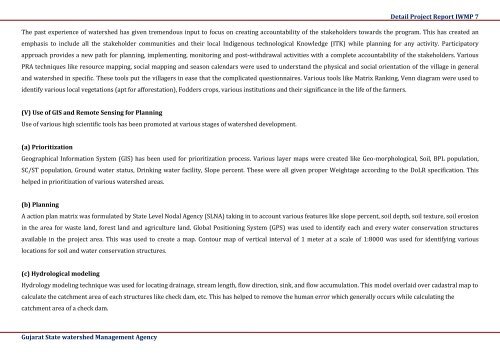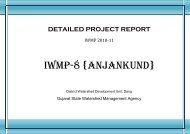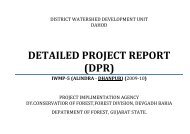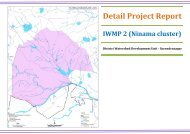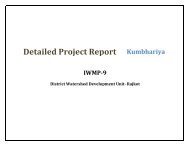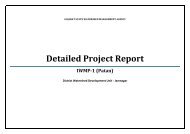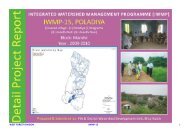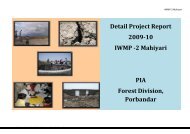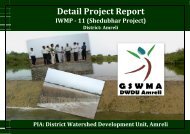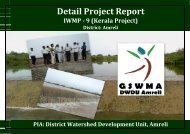IWMP 7 - Commissionerate of Rural Development Gujarat State ...
IWMP 7 - Commissionerate of Rural Development Gujarat State ...
IWMP 7 - Commissionerate of Rural Development Gujarat State ...
You also want an ePaper? Increase the reach of your titles
YUMPU automatically turns print PDFs into web optimized ePapers that Google loves.
Detail Project Report <strong>IWMP</strong> 7<br />
The past experience <strong>of</strong> watershed has given tremendous input to focus on creating accountability <strong>of</strong> the stakeholders towards the program. This has created an<br />
emphasis to include all the stakeholder communities and their local Indigenous technological Knowledge (ITK) while planning for any activity. Participatory<br />
approach provides a new path for planning, implementing, monitoring and post-withdrawal activities with a complete accountability <strong>of</strong> the stakeholders. Various<br />
PRA techniques like resource mapping, social mapping and season calendars were used to understand the physical and social orientation <strong>of</strong> the village in general<br />
and watershed in specific. These tools put the villagers in ease that the complicated questionnaires. Various tools like Matrix Ranking, Venn diagram were used to<br />
identify various local vegetations (apt for afforestation), Fodders crops, various institutions and their significance in the life <strong>of</strong> the farmers.<br />
(V) Use <strong>of</strong> GIS and Remote Sensing for Planning<br />
Use <strong>of</strong> various high scientific tools has been promoted at various stages <strong>of</strong> watershed development.<br />
(a) Prioritization<br />
Geographical Information System (GIS) has been used for prioritization process. Various layer maps were created like Geo-morphological, Soil, BPL population,<br />
SC/ST population, Ground water status, Drinking water facility, Slope percent. These were all given proper Weightage according to the DoLR specification. This<br />
helped in prioritization <strong>of</strong> various watershed areas.<br />
(b) Planning<br />
A action plan matrix was formulated by <strong>State</strong> Level Nodal Agency (SLNA) taking in to account various features like slope percent, soil depth, soil texture, soil erosion<br />
in the area for waste land, forest land and agriculture land. Global Positioning System (GPS) was used to identify each and every water conservation structures<br />
available in the project area. This was used to create a map. Contour map <strong>of</strong> vertical interval <strong>of</strong> 1 meter at a scale <strong>of</strong> 1:8000 was used for identifying various<br />
locations for soil and water conservation structures.<br />
(c) Hydrological modeling<br />
Hydrology modeling technique was used for locating drainage, stream length, flow direction, sink, and flow accumulation. This model overlaid over cadastral map to<br />
calculate the catchment area <strong>of</strong> each structures like check dam, etc. This has helped to remove the human error which generally occurs while calculating the<br />
catchment area <strong>of</strong> a check dam.<br />
<strong>Gujarat</strong> <strong>State</strong> watershed Management Agency


